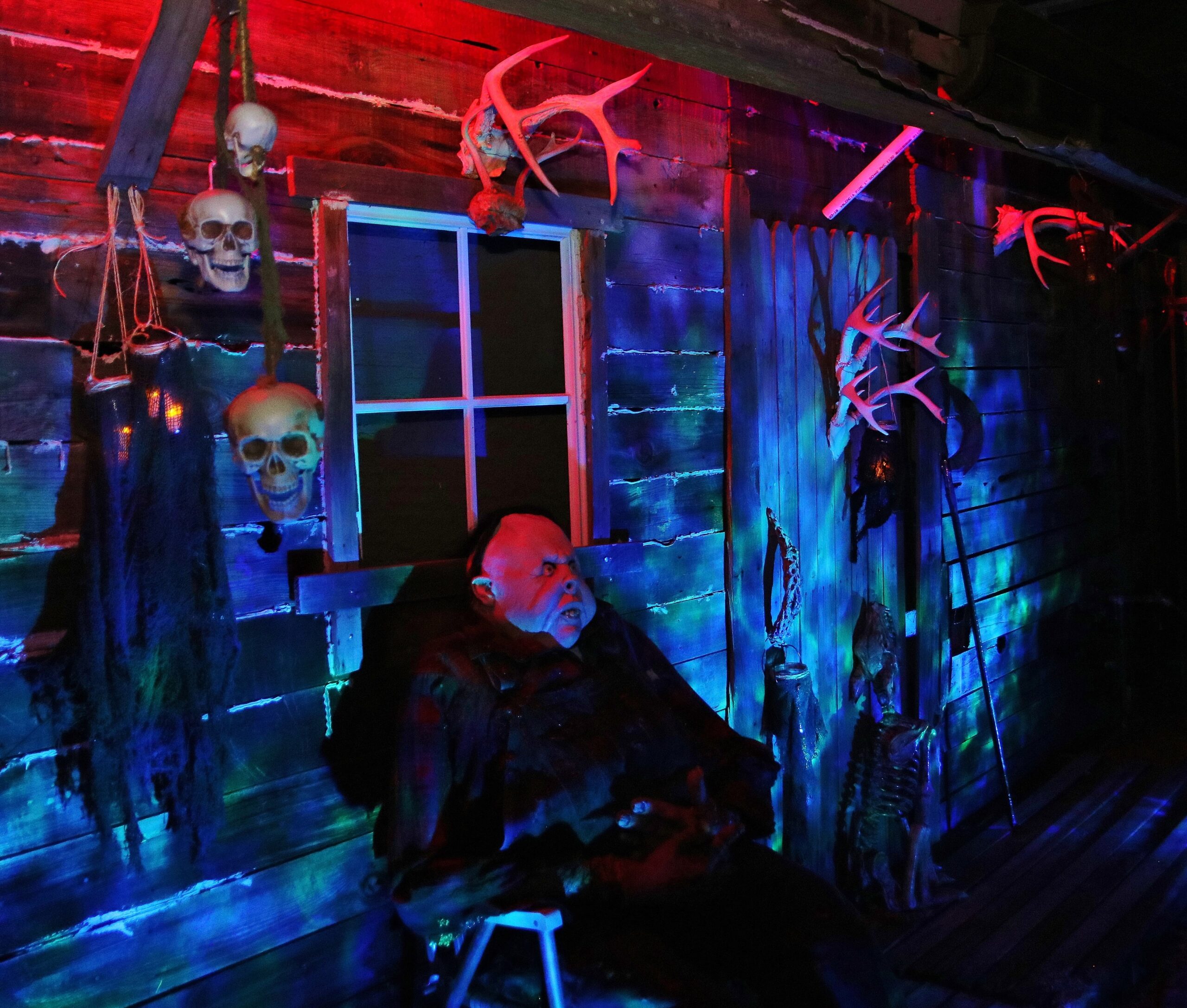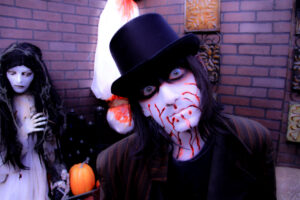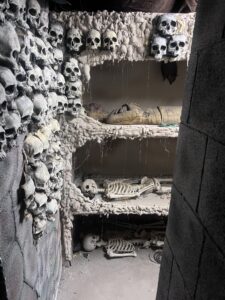Home Is Where the Haunt Is

Phoenix’s Premier Residential Frights
Writer Joseph J. Airdo
Each October in Phoenix, much like werewolves during a full moon, a handful of ordinary suburban homes morph into elaborate theaters of terror, their creators channeling the dedication of museum curators and the passion of performance artists. These aren’t simple yard decorations tossed up for Halloween — they’re immersive experiences that draw visitors from across the Valley, testament to the extraordinary artistry that can bloom in residential settings.
Just south of Greenway Road on the east side of State Route 51, Michaela Nastasia has spent more than a decade perfecting what she calls her “fever dream” — Hellbilly Holler, a cannibalistic Appalachian nightmare that unfolds across her front yard like a twisted theater set.
A few miles away on the other side of the freeway, the Carrillo family has transformed its Ocotillo Hills home into Mount Mayhem, where 1920s carnival freaks and bearded ladies beckon visitors into their carefully crafted world of vintage scares.
Meanwhile, across town in the far north part of Glendale, Rich and Stacy McClellan’s 3,000-square-foot 42nd Haunt has evolved from a garage theme into one of the area’s most elaborate residential productions.
All three displays represent something far more sophisticated than neighborhood Halloween enthusiasm. They’re expressions of genuine artistic vision, community building and the kind of meticulous craftsmanship typically reserved for professional haunted attractions.
Crafting Nightmares From Scratch



“I was originally inspired to create Hellbilly Holler Halloween Haunt for my niece, Athena,” Nastasia explains. “Growing up in Massachusetts, every house in the neighborhood would be decorated for Halloween, but that wasn’t the case when I moved to Phoenix. Very few houses in my new neighborhood were decorated or giving out candy. I wanted Athena to have the same kind of Halloween experience I’d had — where an entire neighborhood comes together to entertain the kids.”
What began as an aunt’s desire to create childhood magic has evolved into something far more complex. Nastasia, a traditional and digital painter of fantasy and horror who has been creating haunts since her teens, draws inspiration from an eclectic mix of sources — from the “Hellbilly” music of Hank Williams III to Algonquin First Nations lore about the cannibalistic windigo spirit.
“I knew I wanted hillbillies and a swamp witch, so naturally a story had to develop between those characters,” she says. “We came up with the idea that the people living in the mountains didn’t have enough to eat, so they made a deal with the swamp witch to procure ‘food’ for them. That food turned out to be tourists hiking in the Appalachian Mountains, which is how cannibalism became our central theme.”
The narrative complexity rivals that of professional theme park attractions. Visitors encounter Madam Athena, a fortune teller warning travelers away from the holler, while hillbillies Jethro, Bocephus and Vincent conspire with Lucia the swamp witch to lure tourists into their lair. The recently introduced Frank SinRata — a 5-foot singing rat — adds an unexpectedly whimsical element to the gore.
“According to our lore, Frank SinRata was once a lover of the swamp witch, but it ended badly,” Nastasia explains. “She stole his soul and singing voice, trapping them in her favorite rat, so now he sings for all eternity in the rat patch of Hellbilly Holler.”
This attention to storytelling extends to the technical execution. Nastasia has embraced AI animation technology to create custom projections of her characters in action throughout the haunt — the swamp witch casting spells, a screaming wendigo, alligators crawling alongside the swamp in her yard. These projections blend seamlessly with practical effects and handcrafted props, many built from repurposed materials.
“Some of our props are store-bought and then modified; others are built completely from scratch,” Nastasia notes. “For instance, I tore down a wooden fence and used the materials to build a cabin.”
The collaborative aspect proves equally important. Nastasia’s niece Athena, now 16, has grown from baby assistant to master craftsperson and the star of award-winning short films that serve as promotional materials for the haunt.
“She’s reached the point where I can hand her unfinished props, paint, tools and materials with just a basic explanation of what I want,” Nastasia says. “We put on some jazz music, I walk away to work on another project, and by the time I return, she’s not only completed the task but made even the plainest tombstone look like it’s 300 years old.”
When Curtains Rise on Terror



On the other side of State Route 51, the Carrillo family — patriarch Rod, matriarch Seneca and son Soleil — has built its own Halloween legacy over 16 years.
“Mount Mayhem began as a small family project, inspired by a shared love of Halloween, haunted houses and storytelling,” Rod explains. “What started as a fun way to transform our backyard into something spooky for neighbors and friends gradually evolved into a full-scale Halloween show — one that soon became an annual tradition.”
The family’s approach to theme development reflects sophisticated artistic planning. Each year’s creative process begins in May with family brainstorming sessions, drawing inspiration from films, books and professional haunted attractions at Knott’s Scary Farm and Universal Studios’ Halloween Horror Nights.
“Some years, our theme comes to us right away — even as we’re packing away sets and costumes from the previous year,” Seneca notes. “Other times, attending haunt conventions helps us refine our ideas. We’ll often hold brainstorming sessions, toss possible titles around in our family group chat, or look for ways to repurpose old props and sets — or create something entirely new from scratch.”
The theatrical aspects extend beyond set design to include makeup, costumes and performance.
“We approach the whole event like a theater production, with a call time for makeup and costumes, actor guidelines, safety talks and plans for crowd flow,” Seneca explains. “Then, when showtime arrives, it’s curtain up. It feels like staging a play — but our reward is screams instead of applause.
“One neighbor says the highlight of his season is hearing the echoes of screams and laughter coming from our house while he sits on his porch. Because we love the response we get, we work hard to keep things fresh and new every year — and that challenge is exactly what keeps us going, year after year.”
The McClellans’ approach at 42nd Haunt in Glendale offers yet another model for residential haunting excellence. Their castle-themed walkthrough experience operates with theater-level professionalism — complete with fire safety protocols, emergency exits, and an off-duty police officer for crowd management.
They also demonstrate the resourcefulness that defines serious residential haunters, constantly repurposing materials to create fresh experiences within budget constraints. Rich notes that what appears to be new construction often represents creative recycling.
“The swamp house out front this year looks new, but we used it in the back last year as a scene you’d walk into with green fog and swamp effects,” he explains. “The morgue table we have — a kid might jump up from that bed in a bedroom scene next year. We recycle everything.”
Beyond the Screams



All three families emphasize accessibility and community impact. For example, two years ago, Stacy personally guided a young cancer patient with mobility challenges through 42nd Haunt, in which rest stations had been specially created to facilitate her experience.
“I rallied the whole crowd for her as she was going through, and everyone was super supportive,” Stacy says. “They all waited at the end to cheer her on as she came out.”
Likewise, Nastasia designed Hellbilly Holler specifically to address limitations she has commonly heard people mention when describing professional haunted houses.
“Many of them dislike mazes, darkness, being approached by actors, getting yelled at or feeling trapped,” she notes. “I completely understand their perspective because I’m claustrophobic myself.”
Her solution creates a more inclusive experience.
“Since it’s a display haunt viewed from the sidewalk and driveway, there’s plenty of room for wheelchairs and baby carriages,” Nastasia explains. “You can still get up close to the props and see everything clearly without walking on uneven ground or navigating small corridors between rooms.”
Beyond accessibility, the McClellans have found their greatest reward in witnessing the transformative power of their entertainment over time. Rich describes watching young visitors return year after year, evolving from terrified children who cry and run back out to confident kids who specifically request the full scare experience.
“That’s probably the best feeling ever — that we’ve created something meaningful for these kids to overcome and grow,” Rich says.
For the Carrillos, community impact extends beyond entertainment to charitable giving. They’ve partnered with Students Supporting Brain Tumor Research for seven years, donating proceeds to support the organization’s work.
“The best part is how it brings people together — across all political affiliations, economic backgrounds, ethnicities and ages,” Seneca observes. “We’ve had folks come through in hijabs, laughing the entire way, or screaming in Spanish. People travel from all across the area, some driving 45 minutes or more. We’ve even welcomed German tourists!”
All three families have created something rare in suburban America — authentic gathering places that transcend typical neighborhood boundaries. Their success demonstrates how residential spaces can become venues for legitimate artistic expression, community building and cultural tradition.
As October nights grow longer and Phoenix temperatures finally begin their descent from triple digits, these three homes stand as monuments to creative passion and community spirit. They prove that the most memorable art often emerges not from galleries or theaters, but from the dedication of neighbors who dare to transform their everyday spaces into extraordinary experiences.
42ndhaunt.com // mountmayhemhaunt.com // hellbillyholleraz.com

